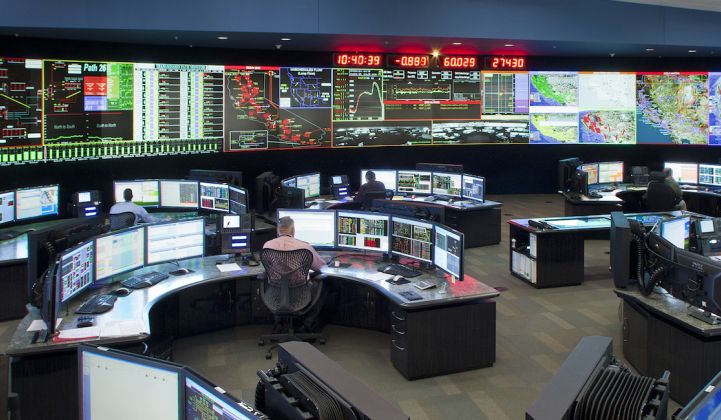The dream of a power grid that is equal parts reliable, affordable and clean may be one of the 21st century's greatest ambitions, and no economy is blazing the trail faster than California.
Between its 50 percent state renewable portfolio standard (RPS), aggressive greenhouse gas (GHG) emission reduction targets, and energy efficiency mandate, California has some of the strictest environmental policies on the books in North America. And these policies are progressively getting more stringent with a potential move toward a 100 percent RPS.
These mandates, which have already pushed an unprecedented number of renewables onto the grid by U.S. standards, have introduced a new set of operational challenges. System operators and regulators are currently preparing for and dealing with consequences such as overgeneration, renewable curtailments, local transmission congestion and flexible backstop procurement in order to keep the system reliable. However, the prospect of a system that is both reliable and clean to the level that California has mandated is simply unattainable without battery and grid edge support.
Since batteries have yet to cross the economic threshold to unleash widespread adoption, and many grid edge solutions will require consensus and cybersecurity vetting, California is scrambling to develop incentives and a framework under which these technologies can begin to thrive and help the state avoid stagnation of its environmental progress
Overgeneration and curtailments
Solar's nature as a non-dispatchable resource that can effectively bid into the market at $0 per megawatt hour or less has led to the problem of overgeneration. Overgeneration occurs when inadequate market size or limited market access due to transmission constraints creates an overabundance of renewable supply. Currently, the best solution for dealing with overgeneration has been to curtail renewable resources either through a market-based system (wherein negative prices disincentivize overgeneration) or through exceptional dispatch (in which CAISO forces renewable resources to curtail).
Curtailment levels in California are continually increasing -- in April alone, curtailments topped out at over 80 gigawatt-hours -- the highest on record (already dwarfing those seen during 2011's hydro glut). Growing curtailments could effectively put California's environmental ambitions on a stagnant treadmill wherein incremental solar can no longer be absorbed during midday hours, causing it to be curtailed, and thereby failing to contribute to RPS targets and GHG displacement.
Moreover, the highest net peak hours (peak demand net of renewables) will increasingly occur after 7 p.m. when the sun is not shining. This shifting net peak consequently reduces the reliability value of solar to the grid, creating reliability challenges in the face of increasing amounts of solar and strained economics of conventional resources.
Need for flexibility
Another consequence of solar saturation is the increasing need for system flexibility. The coincidence of the end-of-day peak (in which customers are returning home from work and causing an uplift in demand) and the setting of the sun (in which solar resources cease to generate power) has created a need for fast-start and flexible resources. This has caused system operators to recognize and design a flexible ramping product and flexible procurement requirements.
In November 2016, FERC approved CAISO's proposed flexible ramping products, the Flexible Ramp Up (FRU) and Flexible Ramp Down (FRD) uncertainty awards, for CAISO's real-time 15-Minute Market (FMM) and 5-minute Real Time Dispatch (RTD) market. The flexible ramping products award payments to resources that can provide ramping capability in the face of demand uncertainty and renewable forecasting errors. While the flexible ramping products address real-time flexibility sufficiency, CAISO is also attempting to tackle flexible resource adequacy via its Flexible Resource Adequacy Criteria and Must-Offer Obligation (FRAC-MOO) initiative.
The FRAC-MOO initiative has grown increasingly necessary as CAISO's three existing procurement constructs, the Long-Term Procurement Plans (LTPP), Resource Adequacy Requirements (RAR) and Capacity Procurement Mechanism (CPM), all lacked a flexibility criterion. Under FRAC-MOO, LSEs are required to procure sufficient flexible resources based off of each month's maximum three-hour ramp and peak demand. The Must-Offer Obligation component of FRAC-MOO ensures that flexible resources meeting technology-agnostic criteria, bid into the CAISO energy markets and not be tied down by self-scheduling.
While the flexible ramping product and FRAC-MOO may be used to attract new flexible resources when the system is approaching a shortfall, given today's sufficiency levels, these flexible incentives act more as retirement prevention tools for existing critical flexible capacity in the face of solar-induced revenue erosion.
The chart below illustrates how the state's 50 percent RPS will impact the state's resource adequacy procurement choices. CAISO currently hosts approximately 35 gigawatts of effective flexible capacity -- a combination of thermal, hydro, demand response and energy storage resources. Each resource's Effective Flexible Capacity (EFC) is often lower than its net qualifying capacity (NQC), depending on individual start-up time, minimum load and average ramp rate constraints.
FIGURE: CAISO Monthly Flexible Demand Scenarios vs. Current Flexible Supply
Current solar and wind penetration levels have only necessitated about 10 to 12 gigawatts of flexible procurement per FRAC. However, the state's rapidly scaling RPS and stagnating demand projections are liable to incentivize new flexible capacity procurements in the near future. According to Wood Mackenzie's calculations, under a 50 percent RPS with majority solar incremental additions (43 gigawatts of incremental solar, 2 gigawatts of incremental wind), an incremental 10 gigawatts of flexible capacity would need to be procured by 2030 in order to meet ramping needs during the shoulder months.
Interestingly, if the state were to take a more balanced approach and grow wind and solar at an even pace, flexible resource adequacy requirements would still rise by roughly 17 gigawatts; however, today's flexible fleet would likely still satisfy this requirement. With that said, this scenario is growing less and less likely.
The federal government recently effectively closed off large swaths of land being eyed by wind developers in California, leading CalWEA to suggest that the state might only have the capacity for just 2 gigawatts of incremental wind development. Given these factors, it's becoming more and more likely that reality will follow the majority solar path. While current and proposed flexible ramping constructs should be sufficient in the medium term, California's long-term environmental goals all but stipulate a shedding of flexible gas resources.
The retirement of gas steamers in California due to once-through cooling requirements is already projected to reduce the state's effective flexible capacity by nearly 9 gigawatts before 2030. Likewise, the specter of growing curtailment demands an innovative solution beyond incremental transmission and reduced minimum loads. Given the current constraints of environmental policies, reliability standards and ratepayer sensitivity, grid edge and energy storage technologies will be key players in balancing these demands.
Grid edge and storage
Proliferation of grid edge technology will allow CAISO to better plan, react, pool resources and take advantage of new demand response opportunities. As an example, the ever-growing CAISO Energy Imbalance Market (EIM) enabled system operators to pool resources across a wider market footprint and consequently reduce renewable curtailments by 27 percent in March of 2017. Current and planned EIM participants include PacifiCorp, NV Energy, Puget Sound Energy, Arizona Public Service, Portland General Electric, Idaho Power Company, Seattle City Light, Balancing Authority of Northern California/SMUD and Salt River Project.
However, EIM's promise to avoid curtailments and reduce flexible reserve requirements is constrained by transfer limits in the real-time market (i.e., available transmission capability with respect to prior scheduling rights and actual flow constraints).
While controversial, increased integration of the Western grid beyond EIM could further the goal of increased system flexibility. While EIM integration will occur in piecemeal increments, the charts below illustrate how Western grid integration at various topology resolutions reduces the need for incremental flexible capacity.
FIGURE: WECC-Wide Flex Capacity Demand vs. Current Supply
FIGURE: 2030 WECC-Wide Flex Capacity Demand vs. Current Supply
As integration resolution decreases, resource and demand pools host increasingly diverse load patterns, EV charging patterns, demand response schedules, wind shapes and solar shapes. This diversity is then leveraged to curb curtailments and reduce flexible reserves, since operators now have more opportunities to match generation with load at their disposal.
A highly integrated WECC could ultimately result in a 13 percent (12-gigawatt) reduction in flexible requirements. Seeing as EIM's $19.65 million total projected price implies a $1.60-per-kilowatt cost of reducing flexible capacity needs (compared to the $900 to $1,000 per kilowatt price tag of new flexible capacity), it's easy to see why new software platforms, expanded data interconnection and other grid edge advancements have begun to garner more interest as an alternative to tangible capacity investments.
In addition to grid edge, energy storage technology such as batteries will broaden the market in which renewables can serve load without being curtailed, acting as a relief valve between the pent-up midday oversupply and the relatively untapped off-peak hours. In doing so, scaled-up storage capacity will reduce the end-of-day ramp and serve as an emission-free flexible resource. California has already passed a modest battery mandate for investor-owned utilities; however, the legislature's consideration of a "Clean Peak" bill aims to do for batteries what the RPS did for solar and wind.
Under a Clean Peak regime, a clean percentage target is set during a predesignated window (intended to coincide with net peak demand). Zero-emission resources are awarded clean peak credits (akin to RECs under RPS regimes) when they deliver power during said time window. Technology requirements are purposefully left open-ended and credits can be derated by carbon content (e.g., batteries that deliver power that was loaded from the wholesale market would get credit equivalent to the ratio of clean megawatts that occurred during the charging period). So while batteries are the intended beneficiary, a Clean Peak standard could also incentivize other renewables, such as wind, whose shapes coincidentally reduce the end-of-day ramp.
Looking forward
The state of California and larger Western Interconnect certainly have their work cut out for them. Absent proactive renewable integration efforts, we're likely just seeing the tip of the iceberg when it comes to renewable curtailments, grid congestion and flexible ramping awards.
Despite the plethora of innovative mitigation efforts and technologies that are starting to emerge, the prospect of growing community-choice aggregators and a 100 percent RPS in California only serve to front-load and double an already tall order. Time will tell if California can rise to this self-imposed challenge. However, preliminary results along the way will be critical, as they will likely guide followers on how to (or possibly how not to) balance the pillars of reliability, affordability and cleanliness in one of the world's largest economies.
***
Join us at Grid Edge World Forum in San Jose, June 27-29, where we'll have three days of sessions that address virtually all facets of the grid edge. We'll have the most influential executives, entrepreneurs and analysts from across the energy sector to meet during unparalleled networking opportunities and exhibition. Come join the audience of global utilities, emerging startups, and fast-growing industries like electric vehicles and customer energy management. Learn more here.



